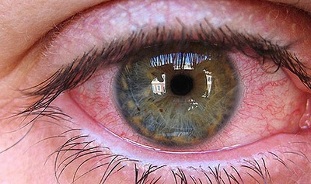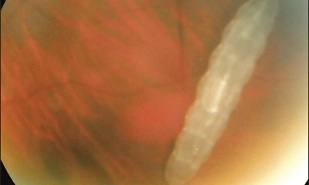
Eye parasites are round, flat, parasites and spiny worms. Flies and mosquito larvae are rare. After they penetrate into the human body, they will gradually spread through the human body, thereby damaging tissues and organs. Most of them can be parasitic in human eyes and cause the development of ocular helminthiasis.
Clinically, these serious pathological manifestations are pain, burning sensation, itching, visual disturbance, and tearing. After diagnosis, immediately undergo surgery and/or conservative treatment.
Diseases caused by parasites in the eye
There are more than 50 pathogens of ophthalmic helminthiasis in humans. Some directly penetrate the mucosa, destroying the conjunctiva or lacrimal duct. Others infect the eyeball from the inside and enter the eyeball through the blood flow in the intestine or liver. The parasites begin to grow and reproduce actively, laying eggs, which causes partial or total loss of vision.
The most common ophthalmic helminths:
- Onchocerciasis-Helminthosis caused by parasitic diseases in the nematode Onchocerca nematodes (onchocercias). Its specific symptom is the ``cloudiness'' of the cornea of the eye;
- Eyeball Dilatationis a parasitic disease of the eyes and its appendages, which occurs when flies or ad larvae enter. In severe cases of muscle weakness, retinal detachment or optic nerve atrophy may occur.
- Filariasis-Helminthiasis develops when filamentous nematode larvae invade the eyeball. The movement of the worm causes a burning sensation, severe pain and itching.
- Sporidiosisis a human disease of the zooepidemic group caused by the larvae of the tapeworm of the genus Helix. Eating infection is mainly when eating meat from wild animals.
- Toxoplasmosisis a chronic infectious disease caused by the larva of Toxoplasma gondii roundworm. The source of infection is diseased animals (usually dogs);
- Toxoplasmosisis a chronic parasite invasion caused by intracellular protozoa (Toxoplasma gondii). Their important activities are accompanied by the continuous release of allergens and toxins.
- Colitisis a major chronic disease that occurs after worm infections in crustaceans with Taworms. A person becomes infected through contact with a dog;
- Cysticercosis-a disease caused by the larva of pork tapeworm, which may cause reduced vision and blindness;
- Mouth distortion-This disease causes severe pain and often leads to death. The worms that cause this disease affect the skin more and less the central nervous system and eyes.
- Eye hydatid diseaseis a fairly common disease. It is characterized by the formation of parasitic cysts in the orbital area. Hydatid disease occurs due to the ingestion of parasite eggs in food or water.
- Eye DemodicosisThe reason is that it activates the mites that live in the eyelid fat glands.
- Trichinosisis a parasitic pathology of Trichinella spiralis introduced into the human body.

It is not sexually mature individuals and larvae that are harmful to the eyes, but the toxins they release. It is the cause of eyelid swelling and mucous membrane redness.
Symptoms of eye parasites
Each worm invasion has its own specific symptoms. But they also have many common signs of damage to mucous membranes and deep ocular structures.
In the initial stage of pathological development, the typical manifestations of conjunctivitis will appear:
- Red eyeball shell;
- Increase tears;
- Photophobia;
- Swelling of the upper and lower eyelids;
- Soreness, itching, burning pain;
- Headaches mostly occur in the temples and back of the head;
- The local temperature increased slightly.
Young children and weak people will have symptoms of systemic poisoning. The temperature rises below the fever level (37. 1-38. 0°C), and the appetite decreases due to nausea and vomiting.
Unlike many infections caused by viruses, bacteria and fungi, the invasion process of worms is accompanied by signs of damage to other organs. These are migratory muscle pain, dry skin, blocked hair growth and indigestion.
How to get rid of parasites in the eyes
Diptera larvae, protozoa, ticks and other parasitic pathogens can quickly destroy the structure of the eye. Therefore, treatment is performed immediately after the diagnosis is made. When choosing a treatment strategy, the doctor will consider the type of infection factors, the severity of the disease course, and the severity of symptoms.If the infected person goes to a doctor with advanced helminthiasis, then conservative treatment usually doesn't work.
The parasite must be surgically removed-the abscess is opened and drained according to accepted rules.
Then use anthelmintics for long-term recovery.
Folk remedies
Even long-term use of powerful modern anthelmintics is often ineffective against such diseases. Urgent surgery is needed to remove larvae, eggs and sexually mature individuals.
Traditional medicine is completely powerless when the eyes are infected by worms. Tansy, chicory, and wormwood cannot cope with eye attacks.
The use of decoctions and infusions can relieve symptoms slightly, so the patient postponed the visit. At the same time, inflammation and destructive processes intensified and spread in his eyeballs. They are prone to retinal detachment and complete or partial blindness.
Medicines
Various treatments for eye diseases caused by worms have been developed. Individual treatment is only performed by specially trained parasitologists. The fact is that after the death of the worm and its decomposition, a toxic allergic reaction occurs in the eye. Only experienced doctors can minimize the consequences.
The following drugs are used to kill parasites:
- Anti-nematode;
- Anti-cutting drug;
- Anti-fluke;
- Broad-spectrum drugs.
For external reagents, use special solutions for flushing eyes. Antihistamines must be included in the treatment plan, and antibiotics and antifungals should also be included when necessary.
Preventive measures
When the mucous membrane of the eyes comes into contact with fruit flies, mid-worms and small ads, myopathy infection occurs. Therefore, infectious disease doctors recommend the use of repellents in the form of sprays, gels, and ointments. Smoke bombs with insecticides can scare away insects in nature.
However, the eggs and larvae of parasite worms are introduced into the human body mainly through food. They have an unstable effect on temperature-they die when heated and boiled. The fruits and vegetables brought from the market must also be washed and stored properly.
Can not diagnose and cure parasitic eye disease independently.
They are usually disguised as bacterial, viral, or fungal infections. And only with their development, their unique characteristics will appear.
Seeing a doctor in time will help save vision and avoid vision loss.



























